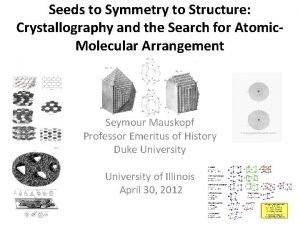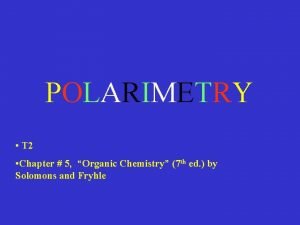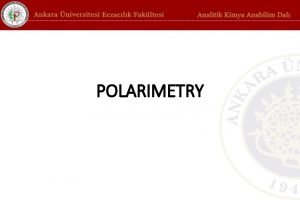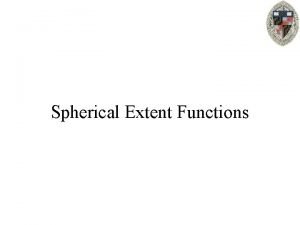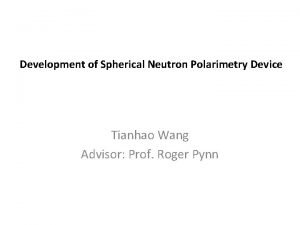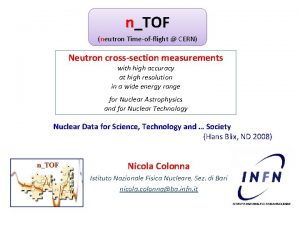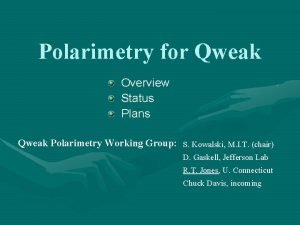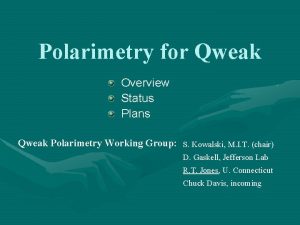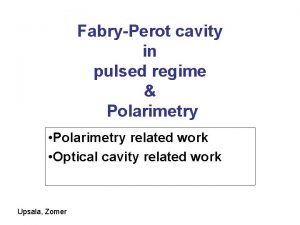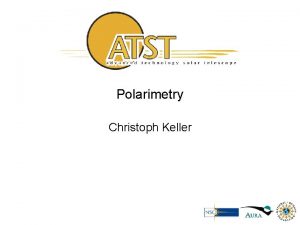Developing Spherical Neutron Polarimetry for wideangle timeofflight neutron









- Slides: 9

Developing Spherical Neutron Polarimetry for wideangle time-of-flight neutron source Tianhao (Radian) Wang 1, 3 B. Winn 1, T. Wang 1, 3, N. Silva 1, F. Li 1, R. Pynn 1, 2 , Chenyang (Peter) Jiang 1 1. Oak Ridge National Laboratory (ORNL) Neutron Technologies Division Neutron Science Division 2. Indiana University Bloomington 3. China Spallation Neutron Source (CSNS) ORNL is managed by UT-Battelle for the US Department of Energy

Table of content 1. Spherical Neutron Polarimetry (SNP) concept and strategy 2. Limitation of SNP on wide-angle time-of-flight measurement 3. Potential theoretical solution to SNP limitation 2 2019 PSTP workshop

Spherical Neutron Polarimetry Principle Advantages: • Access to off-diagonal tensor component • Decouple sample training field with neutron guiding field Requirements: • Proper zero magnetic field shielding • Full-range spin manipulation Geometry of ordinary polarization analysis Pfx Pfy Pfz = Txx Txy Txz Tyx Tyy Tyz Tzx Tzy Tzz 3 2019 PSTP workshop · Pix 0 0 Geometry of Spherical Neutron Polarimetry Pfx Pfy Pfz = Txx Txy Txz Tyx Tyy Tyz Tzx Tzy Tzz · Pix 0 0

Acquiring well-defined non-adiabatic transition through superconductor Isolated region achieved by a combination of: • Meissner Shield (Niobium, YBCO) • Mu-Metal Schematic of a small angle SNP device (Cryo. CUP) 4 2019 PSTP workshop Photo of Cryo. CUP device

Difficulty in applying SNP to time-flight beamline q Combination of adiabatic transition and precession q Adiabatic transition determine the polar angle (ɵ) q Controlled precession determine the azimuthal angle (φ) Traditional SNP neutron polarization manipulation setup Traditional SNP neutron polarization manipulation strategy q Difficulty for applying SNP on wide-angle time-of-flight neutron source Ø Simultaneous wide-angle measurement requires neutron polarization at different direction based on Q Ø Precession manipulation act differently for neutron with different wavelength 5 2019 PSTP workshop

Use rotation matrix to measure Blume tensor and generated polarization z, z 1’, z 2' z x 1' Q 1 y 2' y y 1’ z, z 2' y x 2' x y 2’ x 1' x TBlume ∙ Pi + Pg Pf : final polarization Pi : initial polarization Pg: polarization generated from sample Tblume : Blume Tensor z, z 1' y 1' x 2' Q 2 Pf = Sample y x Blume equation Laboratory coordinate measurement steps 1. Measure initial and final polarization in laboratory coordinate. 2. Determine Blume tensor and generated polarization in laboratory coordinate x-y-z laboratory coordinate: y axis along incoming neutron direction 3. Calculate Tblume and Pg in the scattering z axis points vertically up coordinate based on the angle between the x axis orthogonal to y and z axis two coordinate systems. x'-y’-z’ scattering coordinate: x' axis along scattering vector Q z' axis points vertically up 6 2019 PSTP workshop y’ axis orthogonal to x’ and z’ axis

Applying SNP measurement for wide-angle time-of-flight neutron q Measurement in Laboratory coordinate remains the same direction through different scattering direction. Ø Allows simultaneous wide-angle measurement z, z 1’, z 2' z Sample y y 1’ z, z 2' x 2' General Algorithm x ns y Incoming Neutron x 1' x eu tro Q 1 y 2’ g. N x 1' oin Q 2 y 2' Rθin∙ Pf = Rθin∙TBlume ∙ Rθout-1 ∙ Rθout ∙ Pi + Rθin∙ Pg P’ 7 2019 f. PSTP workshop T’Blume P’i P’g tg x z, z 1' y 1' x 2' q Measure polarization using adiabatic transition Ø No precession needed for polarization manipulation, eliminated wavelength dependency of polarization manipulation Ou y Meissner shield Guide field B Adiabatic transition

Instrument realization of theoretical solution q Technical realization: Measure neutron polarization along two non-parallel Meissner plain adjacent to the zero-field sample chamber M M ei s e ss h i sh ss i ne q Questions to answer before realization: e ie ne l d r Zero field ld 1 Zero field 1 r v Measure along two orthogonal plane B=0 v Covering large scattering angle Zero field B=0 y y 90° x x er n ss d 2 i e M hiel s Guide field B Concept of measurement along two orthogonal direction 8 2019 PSTP workshop v Polarization data and tensor data extraction v measurement error propagation v Off scattering plane signal

Conclusion q Spherical Neutron Polarimetry technique requires neutron polarization control, achieved through superconductor Meissner screen and controlled adiabatic transition and precession q Simultaneous Wide-angle measurement and polychromatic neutron limits the application of SNP on time-of-flight neutron beamline q Using calculation based on rotation matrix between laboratory coordinate and scattering coordinate, we can decouple measurement direction and the scattering direction, which eliminate the limitation on wide-angle and time-of-flight SNP measurement. q Realizing such measurement still requires a lot instrument development work. The polarization development group and Thank you for your attention This work was supported by the U. S. Department of Energy (DOE), Office of Science (OS), Basic Energy Sciences (BES), Materials Sciences and Engineering Division (sample design, fabrication, and physical property characterization) and by the Laboratory Directed Research and Development Program of Oak Ridge National Laboratory (ORNL), managed by UT-Battelle, LLC, for the U. S. DOE (PNR). The research at ORNL’s High Flux Isotope Reactor was sponsored by the Scientific User Facilities Division, BES, U. S. DOE. 9 2019 PSTP workshop
